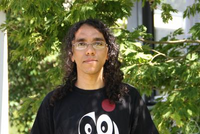Dr. Yuri Santos Rego
Researcher

University of Lincoln
E-mail: YSantosRego(at)lincoln.ac.uk
Homepage: https://www.geometry.ovgu.de/ysantos.htm…
Project
62A unified approach to Euclidean buildings and symmetric spaces of noncompact type
Publications within SPP2026
Reidemeister numbers of group automorphisms encode the number of twisted conjugacy classes of groups and might yield information about self-maps of spaces related to the given objects. Here we address a question posed by Gonçalves and Wong in the mid 2000s: we construct an infinite series of compact connected solvmanifolds (that are not nilmanifolds) of strictly increasing dimensions and all of whose self-homotopy equivalences have vanishing Nielsen number. To this end, we establish a sufficient condition for a prominent (infinite) family of soluble linear groups to have the so-called property R∞. In particular, we generalize or complement earlier results due to Dekimpe, Gonçalves, Kochloukova, Nasybullov, Taback, Tertooy, Van den Bussche, and Wong, showing that many soluble S-arithmetic groups have R∞ and suggesting a conjecture in this direction.
Related project(s):
62A unified approach to Euclidean buildings and symmetric spaces of noncompact type
In this paper we introduce the galaxy of Coxeter groups -- an infinite dimensional, locally finite, ranked simplicial complex which captures isomorphisms between Coxeter systems. In doing so, we would like to suggest a new framework to study the isomorphism problem for Coxeter groups. We prove some structural results about this space, provide a full characterization in small ranks and propose many questions. In addition we survey known tools, results and conjectures. Along the way we show profinite rigidity of triangle Coxeter groups -- a result which is possibly of independent interest.
| Journal | Journal of Algebra |
| Link to preprint version |
Related project(s):
62A unified approach to Euclidean buildings and symmetric spaces of noncompact type
Let K be a number field with ring of integers D and let G be a Chevalley group scheme not of type E8, F4 or G2. We use the theory of Tits buildings and a result of Tóth on Steinberg modules to prove that H^vcd(G(D);Q)=0 if D is Euclidean.
Related project(s):
62A unified approach to Euclidean buildings and symmetric spaces of noncompact type
The Reidemeister number R(φ) of a group automorphism φ∈Aut(G) encodes the number of orbits of the φ-twisted conjugation action of G on itself, and the Reidemeister spectrum of G is defined as the set of Reidemeister numbers of all of its automorphisms. We obtain a sufficient criterion for some groups of triangular matrices over integral domains to have property R∞, which means that their Reidemeister spectrum equals {∞}. Using this criterion, we show that Reidemeister numbers for certain soluble S-arithmetic groups behave differently from their linear algebraic counterparts -- contrasting with results of Steinberg, Bhunia, and Bose.
Related project(s):
62A unified approach to Euclidean buildings and symmetric spaces of noncompact type

